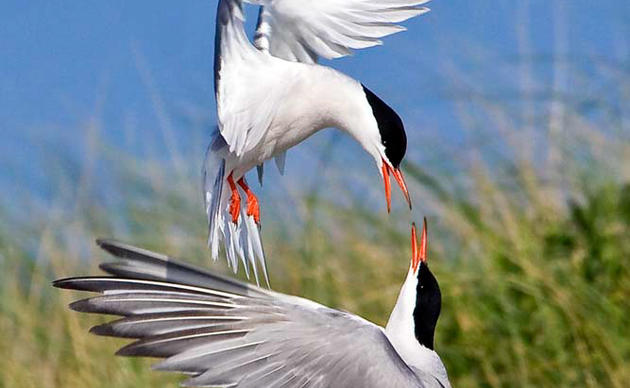Found an injured or dead bird? Visit this page.
Have general bird questions? Visit the Bird FAQ page.
How many birds are killed each year in collisions with windows?
Internationally, estimates vary widely and are likely in the hundreds of millions. Bird collisions are a source of potentially significant and indiscriminate mortality for birds, many of which are already in serious decline due to other pressures. Learn more by reading Bird–building collisions in the United States: Estimates of annual mortality and species vulnerability. This reasearch states that "Building collisions, and particularly collisions with windows, are a major anthropogenic threat to birds, with rough estimates of between 100 million and 1 billion birds killed annually in the United States."
What kinds of birds collide with buildings?
Bird mortality from window strikes has been recorded in more than half the bird species in the United States. Many charasmatic birds are on this list, including Ruby-throated Hummingbirds, Indigo Buntings, Black-capped Chickadees and many others including a number of warblers.
Over 250 species migrate through Minnesota, many of them small songbirds that migrate at night. Some of these are threatened species whose populations already show steep declines. Ironically, common city birds such as rock pigeons and house sparrows are infrequent collision victims. This may be due to these species’ adaptations for living among buildings.
Birds have been migrating for millennia -- why don’t they learn to avoid buildings?
Birds collide with windows in the daytime when they see the outdoors reflected in the glass and think they have a clear flight path. Most migrants fly at night, and the artificial lights in tall buildings confuse them and cause them either to crash into the structure or circle it repeatedly until falling to the ground in exhaustion. Tall, lighted buildings are especially lethal in fog, low clouds and rain.
As the human population grows, we build more and more structures, and the areas that are attractive to humans—riverbanks, coasts, shorelines—are birds’ traditional migratory pathways. Our built environment is proving to be a big challenge to migrating birds.
If buildings are so dangerous, why don’t we see piles of dead birds on the sidewalk each day?
Many of the birds that strike windows are killed outright and fall to the ground where predators, such as gulls, crows, cats and other scavengers quickly carry them off or they are cleaned up by maintenance workers. Those that survive an impact may be too injured to fly and find some place to hide as the city wakes up. Those that retain flight ability may be so frightened by the noise and activity of a city in daytime that they fly up and collide with a building again.
How many birds are killed each year in St. Paul and Minneapolis?
We monitored routes in the Twin Cities for ten years in order to estimate the size of the problem. Trained volunteers surveyed routes in both downtown Minneapolis and St. Paul during spring and fall migration to collect fallen birds. Live birds can often be released or taken to the Wildlife Rehabilitation Center if injured. Dead birds are taken to Bell Museum of Natural History where information is recorded about their age, sex, species, and the location where they were found. To date we have found over 100 species of birds at just a handful of buildings being monitored throughout the state.
Why should we care if some birds are lost on migration in this way?
As stewards of the environment everyone should be concerned about conserving birds. Birds perform many useful functions, from pollination to seed dispersal to insect control. In spring, their return signals the renewal of the seasons and their fall departure precedes the changeover to winter. Their songs and daily activity bring joy to nearly everyone. We can save millions of birds by turning off the lights in tall buildings at night.
BirdSafe Homes: You can help right now by making your home more bird-safe.
BirdSafe Buildings: Larger more commercial buildings can address bird safety during initial design or by retrofitting problem windows. Our Bird-Safe Building Guidelines (PDF, 3.7 MB) provide details and examples.
Lights Out Program: At night, migrating birds can be drawn off course by bright lights in our cities. This program is an effort to reduce unnecessary lighting during spring and fall migration.
BirdSafe Research: With help from volunteers, we monitored designated routes in Minneapolis, St. Paul and Rochester.
How you can help, right now
Donate to Audubon
Help secure the future for birds at risk from climate change, habitat loss and other threats. Your support will power our science, education, advocacy and on-the-ground conservation efforts.
YOU can be a community scientist!
You can volunteer with Audubon Minnesota and help support birds.




